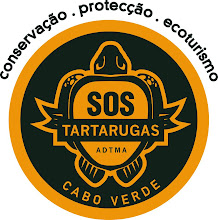Here are a few interesting facts about this year on Sal (the full report will be available in February, email info@turtlesos.org for more information).
Number of tracks / Número de rastos 3,638 (1,280 in 2008)
Number of nests / Número de Ninhos 1,037 (346 in 2008)
The number of turtles killed on Sal was 91, which is an estimated 20% of all turtles, compared to 30% in 2008. A good result but still unacceptable and clearly if it continues extinction may be looming. 60% of those turtles were killed on unprotected beaches that we do not have the resources to patrol.
An astonishing (estimated) 75,000 hatchlings were born, 15% of them (10,000) were released from our two hatcheries.
Outro número surpreendente foi o de 75 000 tartaruguinhas nascidas nestas praias, das quais 15% (cerca de 10 000) foram libertadas nos nossos 2 cercados.
Hatchlings born / Crias nascidas Sal 2009 | ||||
In situ (known) / In situ (nºs confirmados) | 30,724 | |||
In situ (estimated) (estimativa) | 33,216 | |||
Main hatchery / Cercado principal | 9,920 | |||
Surf Beach hatchery / Cercado | 1,170 | |||
Total | 75,030 | |||
Once again, the area on the west coast in front of two of the major developments of Cotton Bay and Paradise Beach won the prize for the most nests, followed closely by the northern beach of Serra Negra and the east coast beach closest to Santa Maria – Ponta Jelonga. One of the biggest surprises was Surf Beach (Praia Antonio de Sousa) – a tiny beach that had 26 nests but is under huge pressure from lights of businesses and residences – meaning all of those nests had to be removed.
Uma vez mais a área Este da ilha, em frente a dois dos maiores empreendimentos da Cotton Bay e Paradise beach, foi onde se registou o maior número de ninhos, seguindo-se (com valores muito próximos) da área da Serra Negra e da praia mais próxima de Santa Maria - Ponta Jelonga. Uma da maiores surpresas foi a Praia António Sousa (Surf Beach) que, apesar do seu tamanho reduzido e da agressão da iluminação dos negócios e residências, registou o aparecimento de 26 ninhos que mais tarde tiveram de ser relocados.
And finally, hatching success improved this year both on the beaches and in our hatcheries – 80% up from 72% last year. E finalmente o número do sucesso: 80% +8% foi o aumento do nascimento de tartarugas registado tanto nas praias como nas nossas 2 incubadoras em relação ao ano passado.
A SOS Tartarugas agradece a todos os interesse e apoio demonstrado durante esta época.
This post is dedicated to Rasher, well loved team member and mascot, killed through strychnine poisoning at the main hatchery 8th October 2009, aged only six and missed greatly.
Esta edição é dedicada ao nosso querido Rasher, a mascote, amigo e indispensável membro da nossa equipa que, para grande desgosto de todos foi morto através de envenenamento por estricnina. Aconteceu no passado 8 de Outubro na incubadora principal, tinha 6 anos e deixou muitas saudades.










